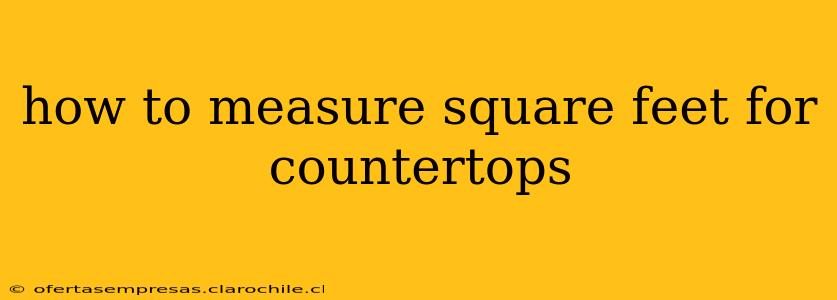Replacing or installing countertops is a significant home improvement project. Accurate measurements are crucial for ordering the right amount of material and avoiding costly mistakes. This guide will walk you through how to measure square footage for countertops effectively, ensuring a smooth and successful installation.
What Tools Do I Need to Measure Square Feet for Countertops?
Before you begin, gather these essential tools:
- Measuring Tape: A long, flexible measuring tape (at least 25 feet) is essential for accurate measurements.
- Pencil: To mark measurements on your countertop or a sketch.
- Calculator: For calculating the total square footage.
- Notebook or Paper: To record your measurements.
- Camera: Taking photos of your countertops and any unique features will be helpful.
How to Measure Standard Rectangular or Square Countertops
For standard rectangular or square countertops, the calculation is straightforward:
- Measure the Length: Measure the length of the countertop in feet and inches.
- Measure the Width: Measure the width of the countertop in feet and inches.
- Convert to Feet: Convert any inch measurements to feet (e.g., 6 inches = 0.5 feet).
- Calculate the Area: Multiply the length in feet by the width in feet. This gives you the area in square feet.
Example: A countertop measuring 8 feet long and 3 feet wide has an area of 8 ft * 3 ft = 24 square feet.
How to Measure L-Shaped or U-Shaped Countertops
L-shaped and U-shaped countertops require a more segmented approach:
- Divide into Rectangles: Break down the countertop into separate rectangular sections.
- Measure Each Section: Measure the length and width of each rectangle as described above.
- Calculate the Area of Each Section: Calculate the area of each rectangular section.
- Sum the Areas: Add the areas of all the sections together to get the total square footage.
Example: An L-shaped countertop might be divided into two rectangles: one measuring 4ft x 6ft (24 sq ft) and another measuring 3ft x 2ft (6 sq ft). The total area is 24 sq ft + 6 sq ft = 30 sq ft.
How to Measure Countertops with Cutouts or Irregular Shapes
Dealing with cutouts (for sinks, cooktops, etc.) or irregular shapes requires a more nuanced approach:
- Measure the Overall Area: First, measure the overall area of the countertop as if there were no cutouts.
- Measure the Cutouts: Measure the dimensions of each cutout (sink, cooktop, etc.) and calculate their individual areas.
- Subtract the Cutouts: Subtract the total area of the cutouts from the overall area. This will provide the net square footage needed for the countertop material.
For irregular shapes, try to approximate the shape with rectangles and triangles, measure each section, calculate the area of each, and then sum them. Remember to subtract cutouts.
What if My Countertops Have Overhangs?
Overhangs (the countertop extending beyond the cabinet) must be factored into your measurements. Measure the length and width of the overhang separately and add its square footage to the total.
How to Account for Seams and Waste?
Remember to account for seams and material waste when ordering your countertops. Consult with your countertop installer or supplier for guidance on how much extra material to order. They can provide a better estimation based on the type of material and complexity of the installation.
Do I need to measure the backsplash?
While you'll need to measure the backsplash separately, the calculation method is the same as for the main countertop surface. Remember to factor in any cutouts for outlets or other fixtures.
How accurate do my measurements need to be?
Accuracy is paramount. Minor discrepancies can lead to material shortages or excess. It's better to overestimate slightly than underestimate. Double-checking your measurements is always recommended.
By following these steps and taking accurate measurements, you can confidently order the correct amount of countertop material and ensure a successful installation. Remember to always double-check your calculations and consult with a professional if you have any doubts or are working with exceptionally complex shapes.
